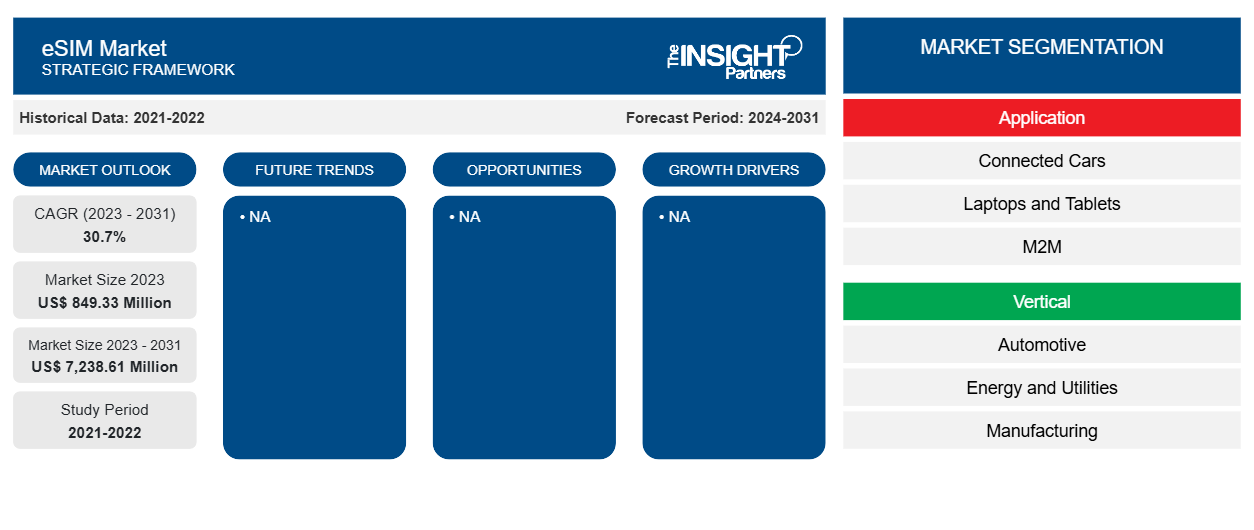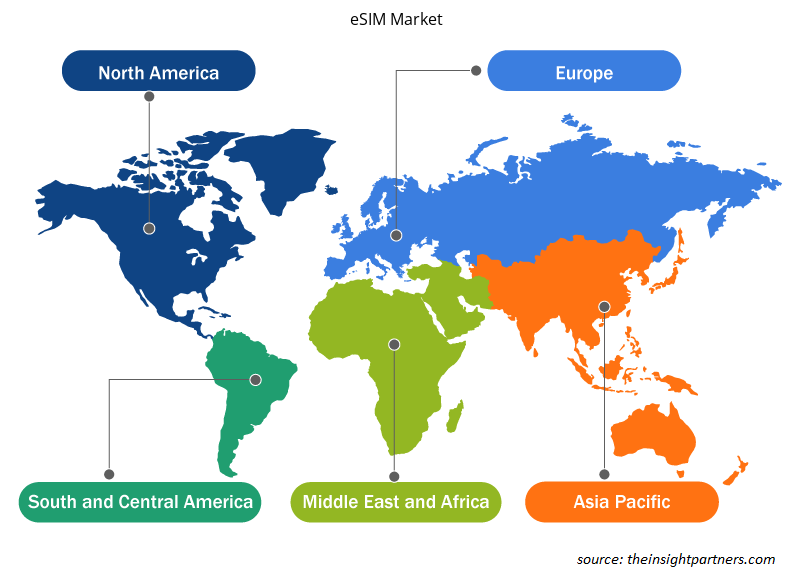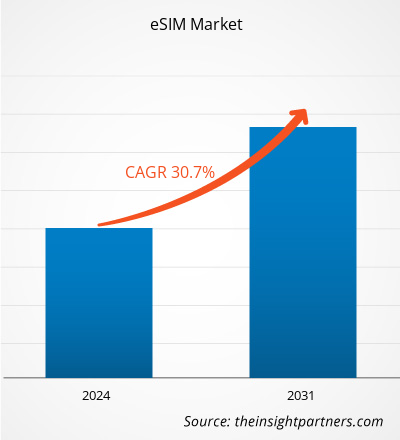Der eSIM-Markt wurde 2024 auf 5,51 Milliarden US-Dollar geschätzt und soll bis 2031 17,98 Milliarden US-Dollar erreichen. Für den Zeitraum 2025–2031 wird eine durchschnittliche jährliche Wachstumsrate (CAGR) von 18,7 % erwartet. Die Integration von KI in das eSIM-Konnektivitätsmanagement dürfte künftig neue Markttrends mit sich bringen.
eSIM-Marktanalyse
Die steigende Verbreitung von Smartphones und die Integration von eSIM in der Automobilindustrie sowie die Kosteneinsparungen treiben die Verbreitung von eSIM voran. Die zunehmende Integration der eSIM-Technologie in Smartphones treibt das globale Wachstum des eSIM-Marktes voran. Da führende Smartphone-Hersteller wie Apple, Samsung und Google weiterhin die eSIM-Funktionalität in ihre neuesten Modelle einbetten, steigen das Bewusstsein und die Akzeptanz bei den Verbrauchern erheblich. Dieser Wandel markiert eine Abkehr von herkömmlichen SIM-Karten und bietet verbesserte Flexibilität, Sicherheit und ein nahtloses Benutzererlebnis. Schätzungen von Telna, Inc. zufolge werden bis 2030 98 % aller Smartphone- Anschlüsse in Nordamerika die eSIM-Technologie nutzen. Das erste eSIM-fähige Smartphone, das Google Pixel 2, wurde 2017 von Google auf den Markt gebracht. Google erweitert die eSIM-Unterstützung seiner Pixel-Reihe kontinuierlich und unterstreicht damit seinen strategischen Fokus auf eine reine eSIM-Zukunft.
eSIM-Marktübersicht
Die eingebettete SIM (eSIM) ist eine digitale SIM-Technologie der nächsten Generation, die eine physische SIM-Karte überflüssig macht. Sie ist direkt in das Gerät integriert und ermöglicht Nutzern das Herunterladen und Aktivieren von Mobilfunkprofilen drahtlos. Diese Innovation verändert die Telekommunikationslandschaft, indem sie mehr Flexibilität, Effizienz und Skalierbarkeit ermöglicht. eSIM vereinfacht den Aktivierungsprozess für Endnutzer, ermöglicht den nahtlosen Wechsel zwischen Netzanbietern und unterstützt mehrere Profile auf einem einzigen Gerät. Dies ist besonders wertvoll für Vielreisende, Remote-Mitarbeiter und Nutzer von Dual-SIM-Geräten, die eine kostengünstige und unterbrechungsfreie Konnektivität ohne lästiges SIM-Kartenwechseln wünschen. Die eSIM-Technologie steigert die Betriebseffizienz deutlich. Sie rationalisiert die Logistik, da die Verteilung und Verwaltung physischer SIM-Karten entfällt. Sie eignet sich ideal für die Verwaltung großer Flotten vernetzter Geräte, darunter Smartphones, Tablets, Wearables und IoT-Hardware. Serviceprovider profitieren von reduziertem Aufwand, verbessertem Kunden-Onboarding und der Möglichkeit, personalisiertere On-Demand-Konnektivitätsdienste anzubieten.
Sie erhalten kostenlos Anpassungen an jedem Bericht, einschließlich Teilen dieses Berichts oder einer Analyse auf Länderebene, eines Excel-Datenpakets sowie tolle Angebote und Rabatte für Start-ups und Universitäten
eSIM-Markt: Strategische Einblicke

-
Informieren Sie sich über die wichtigsten Markttrends in diesem Bericht.Dieses KOSTENLOSE Beispiel umfasst Datenanalysen, von Markttrends bis hin zu Schätzungen und Prognosen.
Treiber und Chancen des eSIM-Marktes
Zunehmende Integration von eSIM in der Automobilindustrie
Die eSIM-Technologie gewinnt in der Automobilbranche rasant an Bedeutung und bietet erhebliche Vorteile gegenüber herkömmlichen SIM-Karten. Im Gegensatz zu herausnehmbaren SIM-Karten werden eSIMs direkt in Fahrzeuge integriert, was eine Fernbereitstellung und ein zentrales Konnektivitätsmanagement ermöglicht. Diese Funktion ermöglicht eine kontinuierliche Fahrzeugkonnektivität und unterstützt unter anderem Echtzeit-Verkehrsinformationen, Navigation zu nahegelegenen Einrichtungen, Ferndiagnose, Over-the-Air-Software-Updates (OTA) und den Zugang zu Notdiensten. Für globale Automobilhersteller optimieren eSIMs in Automobilqualität die Fertigungs- und Lieferkettenprozesse. Ein standardisiertes eSIM-Design kann in alle Fahrzeugmodelle integriert werden, wobei Netzwerkprofile nach der Produktion remote bereitgestellt werden. Dies macht regionsspezifische SIM-Varianten überflüssig, reduziert den logistischen Aufwand und steigert die Betriebseffizienz.
eSIMs bieten erhebliche Vorteile in Bezug auf Sicherheit und Schutz. Sie werden während der Herstellung eingebettet, dienen als sichere Kennung und verschlüsseln die Kommunikation während des Fahrzeugbetriebs, wodurch Datenintegrität und Datenschutz gewährleistet werden. Die Integration von eSIMs als „Root of Trust“ erhöht die Zuverlässigkeit konnektivitätsbasierter Dienste. Darüber hinaus treiben wichtige Akteure Innovationen im Bereich eSIMs voran. So gaben Thales und Cubic im Februar 2025 eine strategische Zusammenarbeit bekannt. Diese Partnerschaft zielt darauf ab, die eSIM-Fähigkeiten von Cubic durch die Nutzung der eSIM-Management-Plattform von Thales zu stärken, die den neuesten GSMA-Standards entspricht. Die Zusammenarbeit ermöglicht nahtlose, skalierbare Konnektivität in verschiedenen Branchen, darunter Automobilindustrie, Transport und Landwirtschaft. Da die Automobilindustrie zunehmend softwaredefinierte Architekturen und vernetzte Mobilität einsetzt, entwickelt sich die eSIM-Technologie zu einem grundlegenden Element für sichere, flexible und weltweit einheitliche Konnektivitätslösungen.
Anstieg der eSIMs für Reisende
Die eSIM-Technologie gewinnt stetig an Bedeutung und wird voraussichtlich physische SIM-Karten als primäre Methode zur Authentifizierung bei Mobilfunkdiensten ersetzen. Aufgrund ihres vollständig digitalen Charakters und der damit verbundenen Vorteile wird erwartet, dass die eSIM im Prognosezeitraum in zahlreichen Branchen, insbesondere in der Reisebranche, einen tiefgreifenden Wandel vorantreiben wird. Laut Daten von Mobilise Global aus dem Jahr 2023 verzeichneten Reiseveranstalter, insbesondere Fluggesellschaften, einen Anstieg der Zusatzeinnahmen pro Passagier um 20 %, wenn während des Buchungsvorgangs Zusatzleistungen angeboten wurden. Darüber hinaus stellte Vodafone im Juni 2025 eine neue digitale Reiseplattform rund um die Travel eSIM vor, die Reisenden unabhängig von ihrem aktuellen Mobilfunkanbieter eine kostengünstige und zuverlässige Datenverbindung bieten soll. Mit der Travel eSIM von Vodafone können Nutzer problemlos mobile Daten hinzufügen und gleichzeitig ihre bestehende Telefonnummer behalten, was eine nahtlose Konnektivität im Ausland gewährleistet. Der Onboarding-Prozess ist einfach und schnell: Vor der Abreise können Benutzer die spezielle App herunterladen oder die Website der Plattform besuchen, einen vorgefertigten Datentarif anpassen oder auswählen und die eSIM innerhalb von Minuten installieren.
Reisende spielen eine wichtige Rolle bei der beschleunigten Einführung von eSIM. In der heutigen digital vernetzten Welt ist ein unterbrechungsfreier Internetzugang zu einem entscheidenden Faktor bei Reiseentscheidungen geworden. 81 % der Reisenden geben die Internetverfügbarkeit als entscheidend für die Wahl des Reiseziels an. Die eSIM-Technologie trägt diesen Anforderungen Rechnung, indem sie Reisenden eine nahtlose Verbindung zu zuverlässigen lokalen Netzwerken ermöglicht, ohne dass sie physische SIM-Karten austauschen müssen, auf ungesichertes öffentliches WLAN angewiesen sind oder überhöhte Roaming-Gebühren zahlen müssen. Diese nahtlose Konnektivität gewährleistet ein unterbrechungsfreies mobiles Erlebnis während der gesamten Reise. Für Reiseveranstalter eröffnen die digitalen Möglichkeiten der eSIM neue Möglichkeiten zur Umsatzdiversifizierung und zur Steigerung der Nebeneinnahmen. Daher wird erwartet, dass das steigende Wachstum bei eSIMs für Reisende in den kommenden Jahren lukrative Möglichkeiten für Marktwachstum bietet.
Segmentierungsanalyse des eSIM-Marktberichts
Wichtige Segmente, die zur Ableitung der eSIM-Marktanalyse beigetragen haben , sind Komponente und Typ.
- Basierend auf den Komponenten ist der Markt in Hardware sowie Software & Services unterteilt. Das Hardwaresegment dominierte den Markt im Jahr 2024.
- Der Markt ist in Consumer-eSIMs, IoT-eSIMs und Reise-eSIMs segmentiert. Das Consumer-eSIM-Segment ist weiter unterteilt in Smartphones, Laptops und Tablets, Wearables, vernetzte Autos und andere. Das Consumer-eSIM-Segment dominierte den Markt im Jahr 2024.
eSIM-Marktanteilsanalyse nach Geografie
- Der eSIM-Markt ist in fünf Hauptregionen unterteilt: Nordamerika, Europa, Asien-Pazifik (APAC), Naher Osten und Afrika (MEA) sowie Süd- und Mittelamerika. Nordamerika dominierte den eSIM-Markt im Jahr 2024. Europa leistet den zweitgrößten Beitrag zum globalen eSIM-Markt, gefolgt vom Asien-Pazifik-Raum.
- Der eSIM-Markt in Nordamerika ist in die USA, Kanada und Mexiko unterteilt. Er wächst rasant aufgrund der steigenden Nachfrage nach flexibler Konnektivität, der Digitalisierung in der Telekommunikation und des zunehmenden grenzüberschreitenden Reiseverkehrs. eSIMs machen physische SIM-Karten überflüssig und bieten Komfort, Sicherheit und Kosteneinsparungen. eTravelSim, Airalo und andere bieten günstige, unbegrenzte oder flexible Datentarife mit breiter US-amerikanischer und internationaler Abdeckung. Verbraucher bevorzugen digitale Dienste mit sofortiger Aktivierung und ohne physische Dokumente. Die Remote-SIM-Bereitstellung ermöglicht Nutzern einen einfachen Anbieterwechsel und unterstützt Unternehmen bei der Optimierung der Geräteverwaltung. Mit der zunehmenden Verbreitung eSIM-kompatibler Geräte verlagert sich der Markt hin zu vollständig digitalen und effizienten mobilen Konnektivitätslösungen.
Regionale Einblicke in den eSIM-Markt
Die Analysten von Insight Partners haben die regionalen Trends und Faktoren, die den eSIM-Markt im Prognosezeitraum beeinflussen, ausführlich erläutert. Dieser Abschnitt behandelt außerdem die eSIM-Marktsegmente und die geografische Lage in Nordamerika, Europa, Asien-Pazifik, dem Nahen Osten und Afrika sowie Süd- und Mittelamerika.

- Holen Sie sich die regionsspezifischen Daten zum eSIM-Markt
Umfang des eSIM-Marktberichts
| Berichtsattribut | Details |
|---|---|
| Marktgröße im Jahr 2024 | 5,51 Milliarden US-Dollar |
| Marktgröße bis 2031 | 17,98 Milliarden US-Dollar |
| Globale CAGR (2025 – 2031) | 18,7 % |
| Historische Daten | 2021-2023 |
| Prognosezeitraum | 2025–2031 |
| Abgedeckte Segmente |
Nach Komponente
|
| Abgedeckte Regionen und Länder |
Nordamerika
|
| Marktführer und wichtige Unternehmensprofile |
|
Dichte der eSIM-Marktakteure: Auswirkungen auf die Geschäftsdynamik verstehen
Der eSIM-Markt wächst rasant. Die steigende Nachfrage der Endnutzer ist auf Faktoren wie veränderte Verbraucherpräferenzen, technologische Fortschritte und ein stärkeres Bewusstsein für die Produktvorteile zurückzuführen. Mit der steigenden Nachfrage erweitern Unternehmen ihr Angebot, entwickeln Innovationen, um den Bedürfnissen der Verbraucher gerecht zu werden, und nutzen neue Trends, was das Marktwachstum weiter ankurbelt.
Die Marktteilnehmerdichte beschreibt die Verteilung der in einem bestimmten Markt oder einer bestimmten Branche tätigen Unternehmen. Sie gibt an, wie viele Wettbewerber (Marktteilnehmer) in einem bestimmten Marktraum im Verhältnis zu dessen Größe oder Gesamtmarktwert präsent sind.
Die wichtigsten Unternehmen auf dem eSIM-Markt sind:
- Giesecke Devrient GmbH
- Telefonica SA
- Deutsche Telekom AG
- IDEMIA France SAS
- Infineon Technologies AG
- Vodafone Group Plc
Haftungsausschluss : Die oben aufgeführten Unternehmen sind nicht in einer bestimmten Reihenfolge aufgeführt.

- Überblick über die wichtigsten Akteure auf dem eSIM-Markt
Neuigkeiten und aktuelle Entwicklungen zum eSIM-Markt
Der eSIM-Markt wird durch die Erhebung qualitativer und quantitativer Daten aus Primär- und Sekundärforschung bewertet, die wichtige Unternehmenspublikationen, Verbandsdaten und Datenbanken umfasst. Im Folgenden sind einige wichtige Entwicklungen im eSIM-Markt aufgeführt:
- Die Infineon Technologies AG präsentiert mit der OPTIGA Connect Consumer OC1230 die branchenweit kleinste GSMA-kompatible und erste 28-nm-eSIM-Lösung. Sie ermöglicht einen bis zu 50 % geringeren Energieverbrauch im Vergleich zu marktüblichen eSIMs und verlängert so die Akkulaufzeit. Die eSIM-Lösung ist für mobile Endgeräte wie Wearables, Tablets, Smartphones und Notebooks konzipiert und bietet zudem eine erweiterte Gerätefunktionalität.
(Quelle: Infineon Technologies AG, Pressemitteilung, Januar 2025)
- STMicroelectronics hat die Zertifizierung seiner eingebetteten SIM (eSIM) ST4SIM-300 gemäß der GSMA SGP.32 eSIM IoT-Spezifikation abgeschlossen. Die ST4SIM-300 gehört zu den ersten zertifizierten eSIMs, die SGP.32 unterstützen. Diese Spezifikation eignet sich für IoT-Geräte mit minimalen Benutzeroberflächen oder eingeschränkter Konnektivität, wie z. B. reine Schmalbandkommunikation. Zu den besonderen Merkmalen von SGP.32 gehören die Massenbereitstellung von SIM-Profilen zur vereinfachten Verwaltung großer Geräteflotten, die Bereitstellung ohne SMS und eine einfache Profilvorlage für optimierte Downloads.
(Quelle: STMicroelectronics, Pressemitteilung, Mai 2025)
Abdeckung und Ergebnisse des eSIM-Marktberichts
Die Studie „eSIM-Marktgröße und -prognose (2021–2031)“ bietet eine detaillierte Analyse des Marktes, die die unten genannten Bereiche abdeckt:
- eSIM-Marktgröße und -prognose auf globaler, regionaler und Länderebene für alle wichtigen Marktsegmente, die im Rahmen des Projekts abgedeckt sind
- eSIM-Markttrends sowie Marktdynamiken wie Treiber, Einschränkungen und wichtige Chancen
- Detaillierte PEST- und SWOT-Analyse
- eSIM-Marktanalyse mit wichtigen Markttrends, globalen und regionalen Rahmenbedingungen, wichtigen Akteuren, Vorschriften und aktuellen Marktentwicklungen
- Branchenlandschaft und Wettbewerbsanalyse mit Marktkonzentration, Heatmap-Analyse, prominenten Akteuren und aktuellen Entwicklungen für den eSIM-Markt
- Detaillierte Firmenprofile
- Historische Analyse (2 Jahre), Basisjahr, Prognose (7 Jahre) mit CAGR
- PEST- und SWOT-Analyse
- Marktgröße Wert/Volumen – Global, Regional, Land
- Branchen- und Wettbewerbslandschaft
- Excel-Datensatz
Aktuelle Berichte
Erfahrungsberichte
Grund zum Kauf
- Fundierte Entscheidungsfindung
- Marktdynamik verstehen
- Wettbewerbsanalyse
- Kundeneinblicke
- Marktprognosen
- Risikominimierung
- Strategische Planung
- Investitionsbegründung
- Identifizierung neuer Märkte
- Verbesserung von Marketingstrategien
- Steigerung der Betriebseffizienz
- Anpassung an regulatorische Trends






















 Kostenlose Probe anfordern für - eSIM-Markt
Kostenlose Probe anfordern für - eSIM-Markt